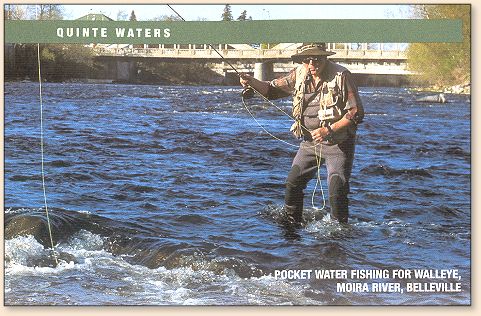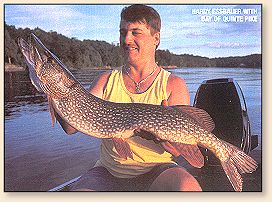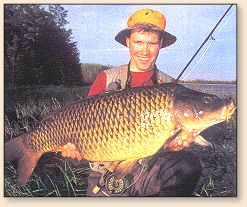 By Chris Marshall
The Country North of Belleville
There are a number of small lakes between Highway
#401 and Highway #7 to the north which are well
worth exploring for pike and bass, but the two
major lakes are Stoco at the village of Tweed and
Moira at the village of Madoc. Besides bass and pike,
these also hold substantial numbers of musky, which
can run over 40 pounds. While, like all musky fishing,
the chances of success are rather unpredictable, they
can be taken on huge streamers from mid summer into
the fall. However, a guide is essential. There is
little shore access to these lakes, but good boat
access is available in Tweed and Madoc.
By Chris Marshall
The Country North of Belleville
There are a number of small lakes between Highway
#401 and Highway #7 to the north which are well
worth exploring for pike and bass, but the two
major lakes are Stoco at the village of Tweed and
Moira at the village of Madoc. Besides bass and pike,
these also hold substantial numbers of musky, which
can run over 40 pounds. While, like all musky fishing,
the chances of success are rather unpredictable, they
can be taken on huge streamers from mid summer into
the fall. However, a guide is essential. There is
little shore access to these lakes, but good boat
access is available in Tweed and Madoc.
RIVERS
The Moira River
The Moira River and its tributaries run through the
heart of the Quinte region. The gradient is low, and
much of the river consists of long, deep sections
where the flow is virtually non-existent. Consequently,
these are best treated as narrow lakes, and a boat is
essential. The shores are hung with willows and lined
with lily beds and cattails, which provide excellent
fishing for bass (predominantly largemouths) and pike,
and there's always the chance of a musky.

However, there are also a number of rocky, streamy
sections of riffle and pool. These have huge
populations of smallmouth. Most are under 9", but
bigger fish up to around three pounds are not infrequent.
In the deeper pools and runs, a big Woolly Bugger
fished close to the bottom will also pick up walleye,
pike, longnose gar, and the occasional channel cat or
musky. It's also possible to sight fish with a weighted
nymph for redfin suckers up to seven or eight pounds
around the margins of the pools and in the shallow
runs and limestone flats. This is challenging fishing
as redfins are shy to take a fly and put up a powerful
fight, often making multiple leaps.
One of the most interesting streamy sections is right
in the middle of downtown Belleville, from the point
where the river interfaces with the Bay of Quinte
upstream to the first of a series of ice control dams.
Here there is a greater variety of fish. In addition
to the species found in the upper reaches of the river,
there are walleye and the occasional rainbow to be taken
in the spring - some of the walleye hang around all summer.
In June, sheepshead (freshwater drum) up to 15 pounds or
more move in to spawn. In the summer, there are largemouth
bass and the occasional mooneye. Then, in the fall, there
is a run of naturally reproducing chinook salmon and lake
whitefish, plus a few rainbows, browns and lake trout from
Lake Ontario.

For everything except for the fall run of chinooks, a
#5 or #6 weight outfit with a floating line and a
variety of weighted poly leaders is ideal. For the
chinook, an #8 or #9 weight is best.
The Trent
The Trent is big water. From its outlet into the Bay
of Quinte at Trenton, it winds north and west to
Peterborough and beyond. What makes it attractive to
the fly fisher is the number of dams, with large plunge
pools and extensive riffly tailwaters. The dams were
built in the early 19th century by the British military
to provide access by canal for warships between Lake
Ontario and Lake Huron via the Severn River, which
empties into Georgian Bay. Today, the canal system
is a Mecca for recreational boaters, and many of the
ams are used for generating electricity.
Besides the numerous dams upstream, there are eight
in the 15km between Trenton and Glen Ross around 15km
to the north. The smallmouth fishing in the tailwaters
is superb, and, because the flow is so much greater than
the Moira, the average size of the fish is much bigger,
and specimens over 3lbs. are not uncommon. While there's
plenty of action with smaller fish in the shallower,
streamy runs just downstream from the plunge pools,
the bigger fish are found in the deeper runs downstream,
especially where there are gravelly drop-off and other
structure. These are best fished with big, buggy flies
(such as Woolly Buggers) on a dead drift close to the
bottom, using a sink-tip line or a weighted poly leader.
In the evenings, poppers and other bugs can be effective
cast just upstream and skated across on the swing. This
is also a good time to try poppers in the plunge pools.
 The tailwater below the first dam in Trenton runs into
the Bay of Quinte. This provides access for a variety
of species which run up from Lake Ontario. In the spring,
there are walleye and a few rainbows, although the water
is usually running too high for safe wading, and the dam
is lined with anglers fishing with bait and lures. However,
there are runs of Pacific salmon, rainbows, lake trout,
and lake whitefish in the fall. At this time the water
is low enough to allow easy wading.
The tailwater below the first dam in Trenton runs into
the Bay of Quinte. This provides access for a variety
of species which run up from Lake Ontario. In the spring,
there are walleye and a few rainbows, although the water
is usually running too high for safe wading, and the dam
is lined with anglers fishing with bait and lures. However,
there are runs of Pacific salmon, rainbows, lake trout,
and lake whitefish in the fall. At this time the water
is low enough to allow easy wading.
The Trent has a number of coldwater tributaries which
feed it from the west. Many offer fly fishing for wild
browns and brookies, although none are easy, especially
after the middle of June. There is public access at
conservation areas operated by the Lower Trent Conservation
Authority.
Non Fly Fishing Attractions and Activities
The Quinte region offers a wide variety of things
to do other than fly fishing, both indoors and
outdoors. This makes the region a perfect destination
for the fly fisher to bring the whole family.
Some of the finest inland sand beaches in the
world can be found on the Lake Ontario shores
of Prince Edward County. These are located in
provincial parks at The Sandbanks, The Outlet,
and North Beach, where there are changing facilities,
lifeguards and plenty of parking spaces. The first
two have overnight camping facilities. The water is
crystal clear and the beaches have long, gentle
gradients, which allow the water to warm up to over
70 degrees. When the wind is blowing strongly from
the south or west, there's even surf!
The Bay of Quinte offers excellent sailing from
marinas in Belleville, Picton, and Trenton, and
there are numerous public access points for windsurfers.
For those fly fishers who stoop to golf there are over
a dozen first class golf courses in the area.
Professional summer theatres in Stirling just north
west of Belleville and in Picton in Prince Edward
County, offer seasons of mainly light comedy
appropriate for lazy summer days. The whole region
is home a wide variety of artisans, including artists,
potters and weavers, and, for those who like to shop,
there are plenty of interesting boutiques in the region,
especially in the villages of Stirling, Bloomfield and
Wellington. Belleville has a huge mall complex at
Highway #401. The Quite region produces the best
cheddar cheese in the world, which is available in
shops right at the cheeseries, and Prince Edward
County is Canada's newest wine growing region, with
a number of wineries offering tasting and tours.
Gourmets will be delighted with the range of restaurants
offering everything from home-made produce to fine dining,
some of which are listed in Canada's register of fine
dining.
Guides and Fly Shops
There is only one location for fly tackle in the area,
Quinte Outdoor Sports in Belleville. This is a large
store with an extensive inventory of outdoor gear
and clothing, hunting supplies and fishing tackle,
but the fly fishing section is small. However, one
of the staff is, Dan Evans, is an experienced fly
fisher and can provide information on local fly
fishing opportunities. There are two local guides
who cater to fly fishers.

Accommodations
The Quinte region is well-known for its B&Bs,
especially in Prince Edward County. There are
major chain hotels in Belleville and Trenton,
and plenty of smaller hotels, motels, and
waterside cabins throughout the region. Details
of these, as well as other information, can be
found at the websites listed below.
Getting There
The hub city of Belleville is located on Highway
#401 just two hours from Toronto, 2½ from Ottawa,
and three from Montreal. All three cities are
served by international airports. Visitors driving
up from the USA should cross at the Thousand Islands
Bridge in upstate New York. Belleville is just a short
1½ hour drive west from the Canadian end.
Open and Close Seasons
These are quite complex. However, except in Lake
Ontario where there is no close season for all
species but lake trout, the trout season runs
from the end of April to the end of September.
Pike and walleye open in early May, while musky
and bass open at the end of June. Visiting anglers
are advised to obtain full details from the Ontario
Ministry of Natural Resources at www.mnr.gov.on.ca
Maps
Topographical maps of the area are available from
Greenley's Bookstore on Front Street in Belleville.
Phone (613) 966-9760.
Boats for Hire
Check out www.quintefishing.com.
Other Useful Information Websites
For more general information about activities,
accommodation, and dining, visit the following
websites:
Belleville & District Chamber of Commerce www.chamber.belleville.on.ca
County of Hastings www.hastingscounty.com
Bay of Quinte Country www.quinte.on.ca
Prince Edward County www.pec.on.ca
Municipality of Tweed www.twp.tweed.on.ca
Trent-Severn Waterway www.trentsevern.com
Quinte Conservation Authority
Lower Trent Conservation Authority
~ Chris Marshall
Credits: This article is from the October/December
2003 issue of the Canadian
Fly Fisher. We appreciate use permission.
Our Man In Canada Archives
|



 The tailwater below the first dam in Trenton runs into
the Bay of Quinte. This provides access for a variety
of species which run up from Lake Ontario. In the spring,
there are walleye and a few rainbows, although the water
is usually running too high for safe wading, and the dam
is lined with anglers fishing with bait and lures. However,
there are runs of Pacific salmon, rainbows, lake trout,
and lake whitefish in the fall. At this time the water
is low enough to allow easy wading.
The tailwater below the first dam in Trenton runs into
the Bay of Quinte. This provides access for a variety
of species which run up from Lake Ontario. In the spring,
there are walleye and a few rainbows, although the water
is usually running too high for safe wading, and the dam
is lined with anglers fishing with bait and lures. However,
there are runs of Pacific salmon, rainbows, lake trout,
and lake whitefish in the fall. At this time the water
is low enough to allow easy wading.
